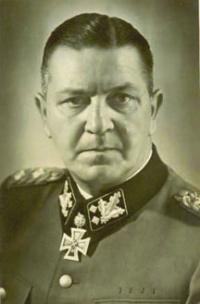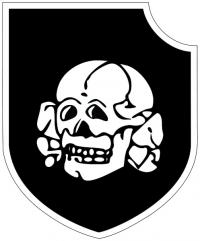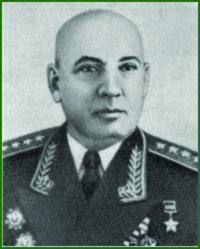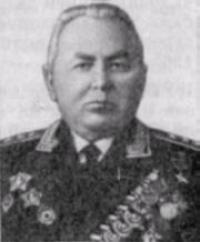Written By: Peter Ayers Wimbrow III, Esq.

SS GruppenfÅhrer Theodore Eicke, commander of Totenkopf Division, shown wearing Knight's Cross with Oak Leaves.

Totenkopf Division logo

Hero of the Soviet Union, Major-General Pavel A. Kurochkin with Hero of the Soviet Union Medal on left breast.

Vasily I. Kuznetsov, commander 1st Shock Army wearing Hero of the Soviet Union just below left shoulder.
This month, seventy years ago, saw the most intensive efforts on the part of the Red Army to reduce the “Demyansk Pocket.” The “Demyansk Pocket” came about as a result of the Red Army’s Winter Offensive, which began on December 6, 1941. After the Soviets had driven Army Group Center, under the Command of Field Marshal Fedor von Bock from the Gates of Moscow, they turned their attention to the besieged city of Leningrad and Army Group North, under the command of Field Marshal Wilhelm von Leeb.
On January 9, future Hero of the Soviet Union, Major-General Pavel A. Kurochkin, sent the Third and Fourth Shock Armies, of his Northwest Front against Army Group North’s 16th Army commanded by Knight’s Cross winner, General Ernst Busch. They were later joined by the 11th and 34th Armies. Eventually, on February 9th, the better part of two German corps - the II and X Armeekorps - were surrounded in a pocket based on the Russian village of Demyansk, which was an important rail link connecting Moscow and Leningrad.
The commander of the II Armeekorps, Knight’s Cross winner, General Count Walter von Brockdorff - Ahlefeldt, was given the command of the forces within the “Demyansk Pocket” because the commander of the X Armeekorps, General Christian Hansen, was outside of the Pocket. The Count had already been awarded the Knight’s Cross for his performance during the French Campaign.
There were three infantry divisions from the II Armeekorps within the Demyansk Pocket - the 12th, from Mecklenburg; 32nd, from Pomerania and Prussia; and the 123rd, from Brandenburg, commanded by, respectively: Colonel Karl Hernekamp (temporarily); General Wilhelm Bohnstedt; and General Irwin Rauch. There were also three infantry divisions from the X Armeekorps: the 30th, from Schleswieg-Holstein; the 290th, from Schleswieg-Holstein and Hanover; and the 3rd SS Totenkopf, commanded by, respectively: Generals Kurt von Tippleskirch and Baron Theodore von Wrede; and Gruppenführer Theodore Eicke.
For requesting permission to withdraw some of his troops in the face of the Red Army’s offensive, Field Marshal von Leeb was relieved of command and replaced by 18th Army’s commander, Knight’s Cross winner General George von Küchler, on January 17, 1942.
On February 8th, units of the General Kurochkin’s 11th Army and the 1st Shock Army, commanded by future Hero of the Soviet Union Vasily I. Kusnetsov, closed the trap on the “Demyansk Pocket” by linking on the Lovat River, about 25 miles west of Demyansk. Luftwaffe Chief, Reichsmarshal Hermann Göring assured der Führer that the 95,000 trapped men and 20,000 horses could be supplied by air.
During the struggle to hold the “Demyansk Pocket,” the resistance of Eicke’s Totenkopf Division was crucial. It acted as the Pocket’s fire brigade. No Totenkopf position was taken by the Soviets until every Totenkopf soldier was dead.
Eicke, who, in 1934, had been given the task of assassinating Ernst Röhm, head of the S.A., and then tasked with organizing and administering all of the Reich’s new concentration camps, formed the Totenkopf Division, in 1939, from concentration camp guards. Totenkopf means “Death’s Head.”
During the Polish Campaign, the division did not see combat. Rather it was tasked with “police and security” measures behind the lines, which it effected with extreme zeal. The division finally saw combat in the second week of the French campaign. It was during that campaign that it committed its first, of many, war crimes.
A week prior to the invasion of the Soviet Union, Eicke met with his officers and explained that the coming war would be different from those of the past. He explained that this was a death struggle between National Socialism and Jewish-Bolshevism and would demand the most ruthless and uncompromising conduct. He urged his officers to be fanatical and merciless, reminding them that the Soviets had not signed the Geneva Convention and therefore could not be expected to wage war in a civilized fashion.
One advantage that the Totenkopf had over regular German soldiers, other than their superior equipment, training and esprit de corps, was the fact that it did not have to depend on the regular army for supplies, especially winter clothing. Its winter clothing came from SS supply sources, from confiscated goods in Riga. By mid-January, most of the SS soldiers in the Demyansk Pocket had fur-lined parkas, boots, gloves, wool socks and long underwear.
On February 28, Eicke radioed II Armeekorps headquarters that he had lost all contact with neighboring units. But with a slight improvement in the weather from the first week of March the Luftwaffe was able to supply the Totenkopf with food, medicine, ammunition, grenades, mines and automatic weapons. By the second week of March, the Soviets were exhausted and their assaults ceased.
At 7:30 a.m. on March 21, 2011, the X Armeekorps, commanded by Knight’s Cross winner, Lt. General Walter von Seydlitz-Kurzbach launched a relief attack toward the Pocket. The Armeekorps consisted of the 5th and 8th Jäger, and the 122, 127 and 329th Infantry, Divisions. At 11:00 a.m. on April 14th, forces inside the “Pocket” launched an offensive to meet the relief effort. On April 22nd, the two forces met and supplies began coming into the “Pocket.”
On June 26th, at der Führer’s headquarters in Rastenburg, Eicke received the Oak Leaves to the Knight’s Cross he had received on January 15th. In addition, 11 other officers and men of the Totenkopf Division received the Knight’s Cross, which was the most given to any SS Division over such a short period of time. However, by the time of the relief, the Division was broken. It was down to 6,700 men, none of whom were really fit for duty. The division was finally removed from Demyansk and the Eastern Front and transported, first to Germany and then to France to be rebuilt, in October 1942.
During the fight for the “Demyansk Pocket,” the Luftwaffe had delivered almost 60,000 tons of supplies, 31,000 replacement troops and evacuated 36,000 wounded and sick. However, it lost 265 aircraft and 387 airmen. The Voenno-Vozdushanye Sily lost 408 aircraft.
Although this seemed like a victory, and vindication for Hitler’s no retreat order, the seeds of a greater disaster had been sewn. Unquestionably, the defense of the “Demyansk Pocket” had occupied five Soviet armies for almost four months. During the Demyansk operation, 265 tons of supplies per day were needed - and were supplied. The following year, when the 6th Army, elements of the Fourth Panzer Army and two Romanian Divisions, were trapped in Stalingrad, the Reichsmarshal once again guaranteed der Führer that “his” Luftwaffe could keep the trapped forces supplied - even though the Luftwaffe commander on the scene, General Baron Wolfram von Richthofen, told them both it was impossible.
But Stalingrad was different. At Stalingrad there were far more men to supply, requiring an estimated daily minimum of 800 tons be delivered over a much longer distance and faced by a much better organized and equipped VVS. The result was that Baron von Richthofen was correct and it was disastrous for the Axis. The result was the complete destruction of 6th Army.
The village of Demyansk would not be liberated by the Red Army until March 1, 1943.
NEXT MONTH: DOOLITTLE’S RAID and THE DEFENSE OF BATAAN AND CORREGIDOR
Mr. Wimbrow writes from Ocean City, Maryland, where he practices law representing those persons accused of criminal and traffic offenses, and those persons who have suffered a personal injury through no fault of their own.
«Go back to the previous page.



